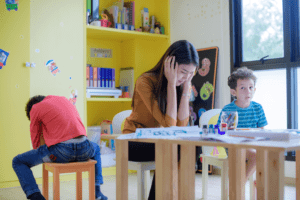Why do teachers need to admit when they’re wrong?
How many times have you heard a teacher not own up to a mistake? ‘I was just testing you!’ is a common excuse, but the truth is that unless you are teaching very young primary aged students, no one believes a word of it.
Many teachers pride themselves on knowing their content. This can become a core part of their identity as a teacher, and it’s a problem. Even if you play it off as a joke, this can leave a lasting impact on your students, their mindset, and how they think about you.
Admitting when you’re wrong has been identified as one of the key characteristics of a highly accomplished teacher.1 There are a number of huge benefits of fessing up and admitting to your students when you’re wrong:
It shows that you are a human being.
This is a big one for teachers. While you do want to maintain some distance between who you actually are and your students, it’s important that your students can empathise with you.

respect.
While there is not nearly as much research on the impact of students being able to empathise with their teachers when compared to the reverse, it’s an important part of being a good role model. If you are someone with who your students feel that they can relate to, it is good for their well-being as well as their growth and goal-setting.
Being regarded as a fully-fledged human being by the people that you spend most of your days with is also very important for teachers’ well-being. It is difficult to feel a sense of fulfilment and respect in your job if you’re not regarded as a person who makes mistakes but is still worthy of respect. Not admitting when you’re wrong does not prevent your students from thinking that you make mistakes, in fact, it can prove to them that you think that you’re better than them.
To build rapport with their students.
Building rapport with your students is essential for any good teacher. The quicker that you can build rapport and a firm relationship built around mutual respect, the easier it is to support your students while they learn. Nothing crushes respect quicker than not being able to admit when you’ve made a mistake.
Respect is always reciprocal. It is very difficult if not impossible to respect someone who does not respect you. By not admitting when you have made a mistake to your students, you are lying to them. They know that you’re lying to them, too. If you’re not going to show them enough respect to not lie to them in order to build this impression that you’re perfect and infallible, how can you expect them to respect you?
You can model how to respond when you are wrong.
When you’ve made a mistake as the teacher in your classroom, you are presented with an opportunity to teach. Most people don’t regard ‘being wrong’ as something that needs to be explicitly taught, but many people who grew up not seeing how it is done well struggle to do it themselves.
By being the kind of person who admits when they are wrong, you are exposing your students to the range of choices that they have. They may have few people in their lives who admit when they are wrong, let alone try to fix the situation and apologise. Your modelling of this behaviour lets your students know that there is more than one way to approach this kind of situation and that they get to choose how they respond.

It is very important in these situations to actually model the entire process of making a mistake and how you respond. This is where thinking aloud can really come in handy: if you verbalise your thought process, you can demonstrate when you realised you were wrong, how you feel about it, and your process of deciding what to do about it.
Apologising is another wonderful thing that our students need to see in the wild so that they can recognise the value of it. It is difficult to impress on young people that they need to be honest and apologise when the adults in their life do not do it when they have made a mistake.
To teach a growth mindset.
When most people think of having a growth mindset, it’s in the context of deficit. This student isn’t going to get there, but that’s okay because they can grow and get better.
What having a fixed mindset is really about is being fixed in your thinking. It is about thinking that you’re not going to get any better at something, but it also works in the reverse. Thinking that you can’t get any worse at something also demonstrates a fixed mindset, and is one of the reasons why high-achievers and gifted students often struggle to adapt after they finish school; they’re not used to failing, and they don’t have the skills to emotionally handle this and grow through it.2
If you demonstrate to your students that you are not perfect, they become less threatened by the idea of imperfection. It’s all well and good to say that no one is perfect, but then if you as their teacher try to paint this image of perfection, they don’t really believe it. If you can’t admit to your own mistakes, clearly you don’t believe it yourself, so why should they?
Why do you need to admit to your students when you’re wrong?
By not admitting when you’re wrong, you’re setting yourself up for failure. Everyone makes mistakes, and your students will know if you’re making them. By not admitting to your mistakes, your students are of course going to learn that this is what people do. They will come to expect this from other adults in their lives as well, and may start to emulate the behaviour themselves.
What do you think? Do you struggle to admit when you’re wrong in class? How to you model what to do when you make a mistake? Comment down below!
References:
1Thompson, S., Greer, J. G., & Greer, B. B. (2004). Highly qualified for successful teaching: Characteristics every teacher should possess. Essays in Education, 10(1), 5.
2Lamont, R. T. (2012). The fears and anxieties of gifted learners: Tips for parents and educators. Gifted Child Today, 35(4), 271-276.





